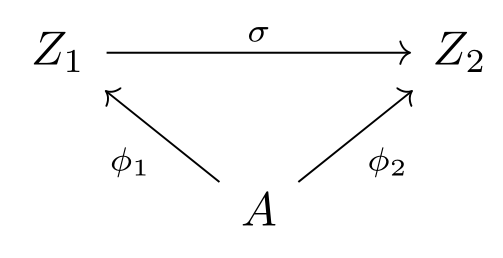Universal properties. Quotient.
A construction is said to satisfy a universal property or be the solution to a univeral problem when it may be viewed as a terminal object of a certain category.
The concept of a quotient can be viewed from this perspective. The idea is expressed (somewhat loosely) as follows:
Quotients, as universal properties. Proposition.
Let \( \sim \) be an equivalence relation defined on a set \( A \).
The quotient \( A / \sim \) is universal with respect to the property of mapping \( A \) to a set in such a way that equivalent elements have the same image.
There is quite a lot that is implicit in this statement. A more explicit definition is as follows:
Quotients, as initial objects. Proposition.
Let \( \sim \) be an equivalence relation defined on a set \( A \). Formulate a category \( \cat{C} \) as follows:
- An object of \( \cat{C} \) is any function \( \phi : A \to Z \) to any set \( Z \) such that for any \( a', a'' \in A, a' \sim a'' \implies \phi(a') = \phi(a'') \).
- A morphism \( \sigma \in \cathom{C}(\phi_1, \phi_2) \), for objects \( \phi_1 : A \to Z_1 \) and \( \phi_2 : A \to Z_2 \), is a function \( \sigma : Z_1 \to Z_2 \) such that \( \sigma \; \phi_1 = \phi_2 \).
Proposition: the function \( A \to A / \sim \) is an initial object of the category \( \cat{C} \).
The proof of this proposition is on the reverse side.
The flip side also has a diagram highlights the nature of the above category. It's a good exercise to try and guess it's form.
Category diagram

Are there any final objects?
The category formulated above does have final objects, but they are not interesting: a function to a singleton set is a final object of the category.
TODO: proof
Essence
Any object in the category can be placed into a one-to-one correspondence with the quotient object and a morphism from the quotient. In other words, in the original set, any function \( f \) satisfying the criteria (that elements of the same partition map to the same elements) can be uniquely decomposed into a composition of quotient function (function from set to partition) followed by a function \( g \). In other words, there is a injection between all functions like \( f \) and the functions like \( g \) that compose with the quotient projection (not sure if projection is the right word here).
